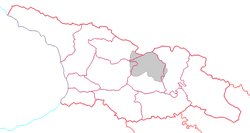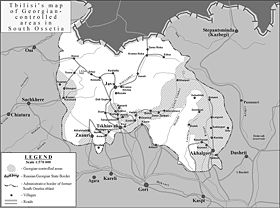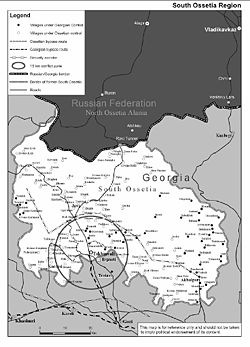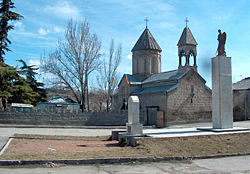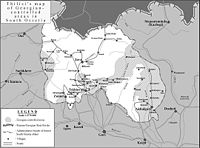South Ossetia
2008/9 Schools Wikipedia Selection. Related subjects: Europe; European Countries
| Хуссар Ирыстон სამხრეთ ოსეთი Южная Осетия South Ossetia
|
||
|---|---|---|
|
|
||
|
Areas controlled by Georgian government are colored grey - according to Georgian sources
|
||
| Area | ||
| - | Total | 3,900 km² 1,506 sq mi |
| - | Water (%) | negligible |
| Population | ||
| - | 2000 estimate | 70,000 |
| - | Density | 18/km² 46.6/sq mi |
| Time zone | ( UTC+3) | |
South Ossetia ( Ossetian: Хуссар Ирыстон, Khussar Iryston; Georgian: სამხრეთ ოსეთი, Samkhret Oseti; Russian: Южная Осетия, Yuzhnaya Osetiya) is a region in the South Caucasus, formerly the South Ossetian Autonomous Oblast within the Georgian Soviet Socialist Republic, part of which has been de facto independent from Georgia since its declaration of independence as the Republic of South Ossetia during the Georgian-Ossetian conflict early in the 1990s. Its independence has not been recognized by any United Nations-member state which continue to regard South Ossetia as part of Georgia. Georgia has retained control over parts of the region's eastern and southern districts where it created, in April 2007, a Provisional Administrative Entity of South Ossetia) headed by ethnic Ossetians (former members of the separatist government) which would negotiate with central Georgian authorities regarding its final status and conflict resolution.
Political status
The United Nations, European Union, OSCE, Council of the European Union, NATO and most of the countries around the world recognize South Ossetia as part of Georgia. However, the de facto independent republic governed by the secessionist government held a second independence referendum on November 12, 2006, after its first referendum in 1992 was not recognized by the international community as valid. According to the Tskhinvali election authorities, the referendum turned out a majority for independence from Georgia where 99% of South Ossetian voters supported independence and the turnout for the vote was 95% and the referendum was monitored by a team of 34 international observers from Germany, Austria, Poland, Sweden and other countries at 78 polling stations. However, it was not recognized internationally by the UN, European Union, OSCE, NATO and the Russian Federation, given the lack of ethnic Georgian participation and the legality of such referendum without recognition from the central government in Tbilisi. The European Union, OSCE, NATO and the USA condemned the referendum. Parallel to the secessionist held referendum and elections, the Ossetian opposition movement ( The Salvation Union of South Ossetia) to Kokoity, organised their own elections in which both Georgian and some Ossetian inhabitants of the region voted in favour of Dmitri Sanakoev as the alternative President of South Ossetia. The alternative elections of Sanakoev claimed full support of the ethnic Georgian population. In 2007, Dmitri Sanakoev became the head of the Provisional Administration of South Ossetia.
On July 13, 2007, Georgia set up a state commission, chaired by the Prime Minister Zurab Noghaideli, to develop South Ossetia's autonomous status within the Georgian state. According to the Georgian officials, the status will be elaborated within the framework of "an all-inclusive dialogue" with all the forces and communities within the Ossetian society.
History
Medieval and early modern period
The Ossetians are originally descendants of the Alans, a Sarmatian tribe. They became Christians during the early Middle Ages, under Georgian and Byzantine influences. Under Mongol rule, they were pushed out of their medieval homeland south of the Don river in present-day Russia and part migrated towards and over the Caucasus mountains, to Georgia where they formed three distinct territorial entities. Digor in the west came under the influence of the neighboring Kabard people, who introduced Islam. Tualläg in the south became what is now South Ossetia, part of the historical Georgian principality of Samachablo where Ossetians found refuge from Mongol invaders. Iron in the north became what is now North Ossetia, under Russian rule from 1767. Most Ossetians are now Christian (approximately 61%); there is also a significant Muslim minority.
South Ossetia under Russia and the Soviet Union
The modern-day South Ossetia was annexed by Russia in 1801, along with Georgia proper, and absorbed into the Russian Empire. Following the Russian Revolution, South Ossetia became a part of the Menshevik Georgian Democratic Republic, while the north became a part of the Terek Soviet Republic. The area saw a series of Ossetian rebellions during which claims for independence were made. Georgian government accused Ossetians of cooperating with Bolsheviks. According to Ossetian sources about 5,000 Ossetians were killed and more than 13,000 subsequently died from hunger and epidemics.
The Soviet Georgian government established by the Russian 11th Red Army in 1921, created the South Ossetian Autonomous Oblast (i.e. district) in April 1922. Although the Ossetians had their own language ( Ossetian), Russian and Georgian were administrative/state languages. In the Soviet time, under the rule of Georgia's government, it enjoyed some degree of autonomy, including to speaking the Ossetian language and teaching it in schools.
Georgian-Ossetian conflict
The tensions in the region began to rise amid the rising nationalism among both Georgians and Ossetians in 1989. Prior to this, the two communities of the South Ossetian Autonomous Oblast of Georgian SSR had been living in peace with each other except for the 1918-1920 events.
Influential South Ossetian Popular Front (Ademon Nykhas) was created in 1988. On 10 November 1989 South Ossetian regional council asked the Georgian Supreme Soviet for the region to be upgraded to autonomous republic. In 1989 the Georgian Supreme Soviet established Georgian as the principal language countrywide.
The Georgian Supreme Soviet adopted a law barring regional parties in summer 1990. This was interpreted by Ossetians as a move against Ademon Nykhas and led to Ossetians proclaiming South Ossetia a Soviet Democratic Republic, fully sovereign within the USSR. Ossetians boycotted subsequent Georgian parliamentary elections and held their own contest in December. The Georgian government headed by Zviad Gamsakhurdia declared this election illegitimate and abolished South Ossetia's autonomous status altogether on 11 December, 1990.
Violent conflict broke out towards the end of 1991 during which many South Ossetian villages were attacked and burned down as well as Georgian houses and schools in Tskhinvali, the capital of South Ossetia. As a result, approximately 1,000 died and about 100,000 ethnic Ossetians fled the territory and Georgia proper, most across the border into North Ossetia. A further 23,000 ethnic Georgians fled South Ossetia and settled in other parts of Georgia. Many South Ossetians were resettled in uninhabited areas of North Ossetia from which the Ingush had been expelled by Stalin in 1944, leading to conflicts between Ossetians and Ingush over the right of residence in former Ingush territory.
At the time of the dissolution of the USSR, the United States government recognized as legitimate the pre- Molotov-Ribbentrop Pact 1933 borders of the country (the Franklin D. Roosevelt government established diplomatic relations with the Kremlin at the end of that year). Because of this, the George H. W. Bush administration openly supported the secession of the Baltic SSRs, but regarded the questions related to the independence and territorial conflicts of Georgia, Armenia, Azerbaijan and the rest of the Transcaucasus — which were integral part of the USSR with international borders unaltered since the 1920s — as internal Soviet affairs.
In 1992, Georgia was forced to accept a ceasefire to avoid a large scale confrontation with Russia. The government of Georgia and South Ossetian separatists reached an agreement to avoid the use of force against one another, and Georgia pledged not to impose sanctions against South Ossetia. However, the Georgian government still retains control over substantial portions of South Ossetia, including the town of Akhalgori. A peacekeeping force of Ossetians, Russians and Georgians was established. On November 6, 1992, the Organization for Security and Cooperation in Europe (OSCE) set up a Mission in Georgia to monitor the peacekeeping operation. From then, until mid-2004 South Ossetia was generally peaceful. In June 2004, tensions began to rise as the Georgian authorities strengthened their efforts against smuggling in the region. Hostage takings, shootouts and occasional bombings left dozens dead and wounded. A ceasefire deal was reached on August 13 though it was repeatedly violated. Presently the situation is tense though largely peaceful, although Moscow and Tskhinvali view the recent Georgian military build-up with concern. The Georgian government protests against the continually increasing Russian economic and political presence in the region, as well as the uncontrolled military of the South Ossetian side. It also considers the peacekeeping force to be non-neutral and demanded its replacement. This criticism was supported, for example, by Richard Lugar, however on October 5, 2006, Javier Solana, the High Representative for the Common Foreign and Security Policy of the European Union, ruled out the possibility of replacing the Russian peacekeepers with the EU force. EU South Caucasus envoy Peter Semneby admitted later that "Russia's actions in the Georgia spy row have damaged its credibility as a neutral peacekeeper in the EU's Black Sea neighbourhood."
Politics
The Republic of South Ossetia consists of a checkerboard of Georgian-inhabited and Ossetian-inhabited towns and villages. The largely Ossetian capital city of Tskhinvali and most of the other Ossetian-inhabited communities are governed by the separatist government, while the Georgian-inhabited villages and towns are administered by the Georgian government. This close proximity and the intermixing of the two communities has made the conflict in South Ossetia particularly dangerous, since any attempt to create an ethnically pure territory would involve population transfers on a large scale.
The political dispute has yet to be resolved and the South Ossetian separatist authorities govern the region with effective independence from Tbilisi. Although talks have been held periodically between the two sides, little progress was made under the government of Eduard Shevardnadze (1993–2003). His successor Mikheil Saakashvili (elected 2004) made the reassertion of Georgian governmental authority a political priority. Having successfully put an end to the de facto independence of the southwestern province of Ajaria in May 2004, he pledged to seek a similar solution in South Ossetia. After the 2004 clashes, the Georgian government has intensified its efforts to bring the problem to international attention. On January 25, 2005, President Saakashvili presented a Georgian vision for resolving the South Ossetian conflict at the Parliamentary Assembly of the Council of Europe (PACE) session in Strasbourg. Late in October, the U.S. Government and the OSCE expressed their support to the Georgian action plan presented by Prime Minister Zurab Noghaideli at the OSCE Permanent Council at Vienna on October 27, 2005. On December 6, the OSCE Ministerial Council in Ljubljana adopted a resolution supporting the Georgian peace plan which was subsequently rejected by the South Ossetian de facto authorities.
Republic of South Ossetia
|
||||||
| Anthem: unknown |
||||||
| Capital | Tskhinvali |
|||||
| Official languages | Ossetian, Russian1 | |||||
| Government | ||||||
| - | President | Eduard Kokoity | ||||
| - | Prime Minister | Yury Morozov | ||||
| De facto independence from Georgia | ||||||
| - | Declared | November 28, 1991 | ||||
| - | Recognition | none | ||||
| Currency | Russian ruble ( RUB) |
|||||
| 1 | Russian in widespread use by government and other institutions. | |||||
On September 11, 2006, the South Ossetian Information and Press Committee announced that the republic will hold an independence referendum (the first referendum had not been recognized by the international community as valid in 1992) on November 12, 2006. The voters would decide on whether or not South Ossetia "should preserve its present de facto status of an independent state". Georgia denounced the move as a "political absurdity". However, On September 13, 2006, the Council of Europe (CoE) Secretary General Terry Davis commented on the problem, stating that it would be unlikely that anyone would accept the results of this referendum and instead urged South Ossetian government to engage in the negotiations with Georgia. On September 13, 2006 EU Special Representative to the South Caucasus, Peter Semneby, while visiting Moscow, said: "results of the South Ossetian independence referendum will have no meaning for the European Union". Peter Semneby also added that this referendum will not contribute to the peaceful conflict resolution process in South Ossetia
South Ossetians nearly unanimously approved a referendum on November 12, 2006 opting for independence from Georgia. The referendum was hugely popular, winning between 98 and 99 percent of the ballots, flag waving and celebration marked were seen across South Ossetia, but elsewhere observers were less enthusiastic. International critics claimed that the move could worsen regional tensions, and the Tblisi government thoroughly discounted the results.
|
|||||||||||
Provisional Administrative Entity of South Ossetia
|
||||||
| Capital | Kurta | |||||
| Official languages | Ossetian, Georgian | |||||
| Government | Provisional Administration | |||||
| - | Head of Administration | Dmitri Sanakoyev | ||||
| - | Interior Minister | Jemal Karkusov | ||||
| Provisional administrative entity of Georgia 1 | ||||||
| - | Established | April, 2007 | ||||
| - | Recognition | None | ||||
| Currency | Georgian lari ( GEL) |
|||||
| 1 | Administration was set up by the Georgian government as a temporary measure before final solution on South Ossetia status. As of June 26, 2007 Georgia is investigating autonomous republic status for South Ossetia within the Georgian state. | |||||
The People of South Ossetia for Peace was founded in October of 2006 by the ethnic Ossetians who were outspoken critics and presented a serious opposition to secessionist authorities of Eduard Kokoity.
The group headed by the former defence minister and then prime minister of secessionist government Dmitri Sanakoev organized the so-called alternative presidential election, on November 12 2006– parallel to those held by the secessionist authorities in Tskhinvali. High voter turnout was reported by the alternative electoral commission, which estimated over 42,000 voters from both Ossetian (Java district and Tskhinvali) and Georgian (Eredvi, Tamarasheni, etc) communities of South Ossetia and Sanakoev reportedly received 96% of the votes. Another referendum was organised shortly after asking for the start of negotiations with Georgia on a federal arrangement for South Ossetia received 94% support. However the Salvation Union of South Ossetia turned down a request from a Georgian NGO, “Multinational Georgia”, to monitor it and the released results were very likely to be inflated.
According to International Crisis Group "Georgian government’s steps are non-violent and development-oriented but their implementation is unilateral and so assertive that they are contributing to a perceptible and dangerous rise in tensions".
Initially the entity of Sanakoev was known as "the Alternative Government of South Ossetia", but during the course of 2007 the central authorities of Georgia decided to give it official status and on April 13 the formation of "Provisional Administration of South Ossetia" was announced. On May 10, 2007 Dmitry Sanakoev was appointed head of the provisional administrative entity in South Ossetia.
An E.U. fact finding team visited the region in January of 2007. Per Eklund, Head of the European Commission Delegation to Georgia said that “None of the two alternatives do we consider legitimate [in South Ossetia],”
Geography
South Ossetia covers an area of about 3,900 km² on the southern side of the Caucasus, separated by the mountains from the more populous North Ossetia (part of Russia) and extending southwards almost to the Mtkvari river in Georgia. It is extremely mountainous, with most of the region lying over 1,000 m (3,300 ft) above sea level. Its economy is primarily agricultural, although less than 10% of South Ossetia's land area is cultivated, with cereals, fruit and vines the major produce. Forestry and cattle industries are also maintained. A number of industrial facilities also exist, particularly around the capital Tskhinvali.
Demographics
Before the Georgian-Ossetian conflict about two thirds of the population of South Ossetia were Ossetians and 25-30% Georgians. The present composition of the population is unknown, although according to some estimates there are 45,000 ethnic Ossetians and 17,500 ethnic Georgians in South Ossetia in 2007.
| census 1926 | census 1939 | census 1959 | census 1970 | census 1979 | census 1989 | |
|---|---|---|---|---|---|---|
| Ossetians | 60,351 (69.1%) | 72,266 (68.1%) | 63,698 (65.8%) | 66,073 (66.5%) | 65,077 (66.4%) | 65,200 (66.2%) |
| Georgians | 23,538 (26.9%) | 27,525 (25.9%) | 26,584 (27.5%) | 28,125 (28.3%) | 28,187 (28.8%) | 28,700 (29.0%) |
| Russians | 157 (0.2%) | 2,111 (2.0%) | 2,380 (2.5%) | 1,574 (1.6%) | 2,046 (2.1%) | |
| Armenians | 1,374 (1.6%) | 1,537 (1.4%) | 1,555 (1.6%) | 1,254 (1.3%) | 953 (1.0%) | |
| Jews | 1,739 (2.0%) | 1,979 (1.9%) | 1,723 (1.8%) | 1,485 (1.5%) | 654 (0.7%) | |
| Others | 216 (0.2%) | 700 (0.7%) | 867 (0.9%) | 910 (0.9%) | 1,071 (1.1%) | 5,100 (4.8%) |
| Total | 87,375 | 106,118 | 96,807 | 99,421 | 97,988 | 99,000 |
Economy
Following a war with Georgia in the 1990s, South Ossetia has struggled economically. Employment and supplies are scarce. Additionally, Georgia cut off supplies of electricity to the region, which forced the South Ossetian government to run an electric cable through North Ossetia. The majority of the population survives on subsistence farming. Virtually the only significant economic asset that South Ossetia possesses is control of the Roki Tunnel that links Russia and Georgia, from which the South Ossetian government reportedly obtains as much as a third of its budget by levying customs duties on freight traffic. The separatist officials admitted that Tskhinvali received more than 60 percent of its 2006 budget revenue directly from the Russian government.
In late 2006, a large international counterfeiting operation stretching from South Ossetia was revealed by U.S. Secret Service and Georgian police.
South Ossetian GDP was estimated at US$ 15 million (US$ 250 per capita) in a work published in 2002.
